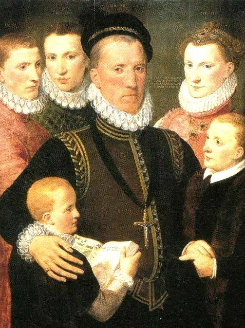|
|
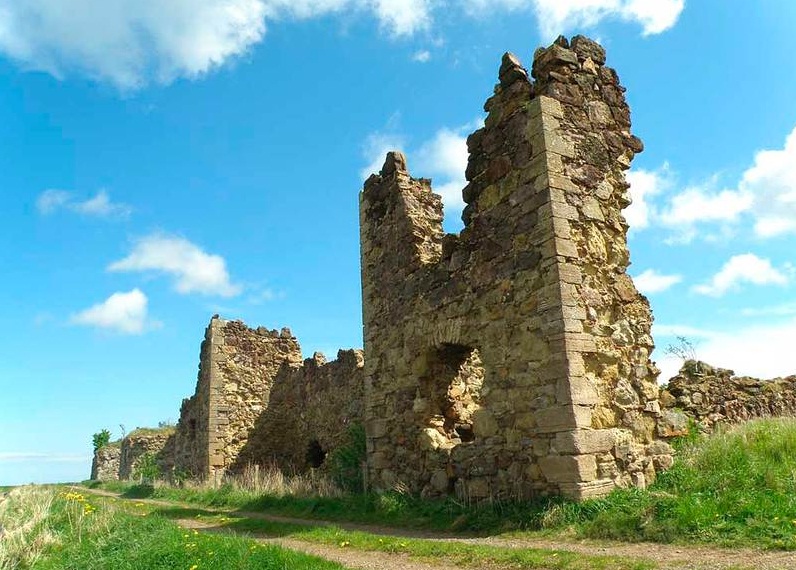 The Seton's of Barnes, Hailes,
'of Moneylagan' in Ireland, Ireland and
Nova Scotia The Seton's of Barnes, Hailes,
'of Moneylagan' in Ireland, Ireland and
Nova Scotia
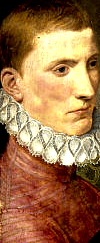
The lands of
Barnes had long been in the family, having been awarded by King
Robert I,
noted in the Index of Charters, &c.
By King Robert I:
Thefe Charters following are on twa
Leiffs of Parchments in form of ane book 1 Carta to Alexander
Seytoun of the barony of Trauernent in vie Edr quhilk William
Ferrars forisfecit and the lands of Fawfyde quhilk Alan le Suche
forisfecit the lands of Mylyis quhilk the Earl of Buchan
forisfecit 2 to Alexander Seytoun of the lands and barony of
Seatoun in liberam baroniam Edinburgh 3 to ditto of the town of
Seatoun in ane burgh of barony 4 to ditto of ane mercat day on
the Sabbath day 5 i to Ditto in French of the lands of Barns and
Place Moylin near Haddingtoun.
20 - to Alexander Seton of the lands
of Bernes juxta Hadingtoun in vie de Edinburgh
Later, re-confirmed yet again by King
Robert III to Sir John Seton as:
7 - "to John Seytoun of the lands of
Bernes and Wintoun"
Of
the Seton's of
Barnes line, they were
occasionally addresed as the "Seaton's
of Mionylangan (Moneylagan) in Ireland after acquiring that estate, and
which stems from Sir John Seton,
2nd of Barnes,
the son and heir of Sir John Seton, Lord Barnes who was himself the 3rd son of George Seton, 7th
Lord Seton and his wife Isabel Hamilton and brother to the 1st Earl
of Winton and to the great Chancellor of Scotland, Alexander
Seton 1st Earl
of Dunfermline. There is also a branch of the Barnes family that
were for a time known by their more
significant estate, as the Seton's of Hailes (or Haillis),
from Sir John Seton's second son, Sir George Seton.
Sir John Seton, 1st of Barnes' initial rearing
was at the Palace of Seton, and had the influences of foreign
dignitaries and the Scottish Royal family of Queen Mary and
James VI. He was Vice Prior of Pluscarden, and showed great promise as a young man, being
studious and yet showing great wisdom in his youth.
Likewise, he displayed great talents in the art of military
service, of law and of languages, being proficient in Scots and
English, as well as French, Latin and Spanish. With his
father's and grandfather's constant services on the Royal
family, it is of no wonder that he was influenced by the
activities at Court, and in the Diplomatic Service.
Besides the family estate' of Barnes, which
he had from his father in May 1585, Sir John also had a grant of
land from King James VI while in his youth. King James him
the property of Hailyards, forfeited by James Earl of Morton
"for crimes of lese "majestie", however Sir John having been
under age at the time of the gift, King James later had to
revoke it on 14th November 1582.
His estate was enlarged at a later date to
include most of the lands around Amisfield, including Easter and
Wester Barnes; those awarded in Galloway; St. Laurence House in
Haddington and others. On the 5th of March 1591-2 there is
a confirmation by the King of a charter by ' William Seytoun,
brother-german of Robert, Lord Seytoun, to John Seytoun of
Barns, Knight, of the half of the lands of Ouhytepark and
others, in the lordship of Galloway, below Cree, and of Aultoun
and others above Cree, with manors, castles, etc.'
While in France with
his father and brothers he demonstrated the high sense of honour,
dignity and service and style, also portrayed by his father and
grandfather, and served in the Scots Guards in France; serving
the French Royal Court as well as the influential family of
Guise. From these connections he was introduced to the
Ambassador of the Spanish Court, and being able to serve as an
Ambassador-liaison for his father on many occasions, greatly
impressed the Spanish Ambassador by his talents. He was
referred to the Court of King Phillip II by the Spanish
Ambassador with the highest regards, and having received an
invitation from the Court there, was presented with a Commission
from Queen Mary to serve as an Ambassador in Spain.
Sir Richard
Maitland of Lethington wrote in his 'History', that Sir John
Seton was a brave young man who after being sent to
France and Rome for his education he went to
Spain, to the court of King Phillip II, by whom he was
made Knight of the Royal Order of St Jago, at that time the
order of knighthood in that kingdom of greatest esteem; In
memory whereof, he and his heirs, bear a sword in their coat of
arms, being the Badge of that Order.
It was during the time
of the troubles of Queen Mary Stuart, that Sir John had relayed
information between his father and the Spanish Court, trying to
bring assistance to her aid, on several occassions. Where
King Phillip had been proposed as a husband to the young Queen
and who had a great interest in supporting her throughout her
life, Sir John was liaison between the King of Spain and the
Scottish Royal House, before being recommended with the highest
honours from the Spanish Ambassador in France. Queen Mary
Stuart then sent him on a commission as a Diplomat and
Ambassador to the Royal Court of King Phillip of Spain.
Given his skills and
mastery of many talents and of his sense of honour and loyalty, King Phillip
later preferred him to be a gentleman of his chamber, and "Cavalier de la
Boca" (which is Master of the Household): he also carried the golden key
at his side, in a blue ribbing; all which, were the greatest honours
King Phillip could give to any of his subjects, except to be
made a Grandee of Spain. For his many services, he had a pension granted to him and his
heirs, of two thousand crowns yearly. While Maitland of
Lethington was later at the Court of the King of Spain, he noted
of the reputation of Sir John Seton that, "I was certainly informed of
the truth of all this."
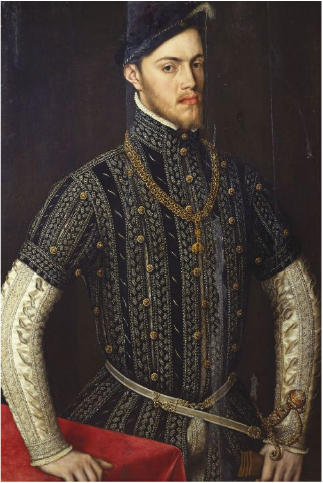 At the heights of his favour with King Phillip of Spain, was
commanded home by King James the Sixth, unwilling to want so
gallant a subject out of his court and service. Upon his return
home, King James preferred him to be Treasurer of
his House and was in great favour with his Majesty. He was
created Lord Barnes (1587 to 1594) of the Lords of Session
in Parliament as an Ordinary Lord, in the place of his younger
brother Alexander promoted. Following his services and
reputation in Spain, he was likewise created Master
of the Kings Household (like that of his father), and Master of
the Kings Horse, and was added Treasurer of the Royal Household
as well. At the heights of his favour with King Phillip of Spain, was
commanded home by King James the Sixth, unwilling to want so
gallant a subject out of his court and service. Upon his return
home, King James preferred him to be Treasurer of
his House and was in great favour with his Majesty. He was
created Lord Barnes (1587 to 1594) of the Lords of Session
in Parliament as an Ordinary Lord, in the place of his younger
brother Alexander promoted. Following his services and
reputation in Spain, he was likewise created Master
of the Kings Household (like that of his father), and Master of
the Kings Horse, and was added Treasurer of the Royal Household
as well.
He was and active
member of the Scottish Parliament during his tenure on the bench
as Lord Barnes (Barns/Barnis), and many legal documents
are to be found within the Records Office in Edinburgh, noting
Sir John Seton and having his Seal upon them. He was also
was part of the coalition that had begun to put forward the
succession of King James to the English crown, along with his
two brother's who were at that time Robert, 8th Lord Seton; and
Alexander, Lord Fyvie and Prior of Pluscarden. As Vice
Prior of Pluscarden, he had acquired various lands, including
those in the Lordship of Galloway, On 29 July 1592 he had a
charter of the lands of Culcaigreis and others, in the lordship
of Galloway-under-Cree, which he sold to Thomas Maclellan of
Bombie.
His initial
residence was at the Seton's mansion at St. Germains House,
beside the Palace of Seton and which had at that time consisted
of the main block, tower and courtyard. However, given the
impressions that were left upon him from his service in Spain,
Sir John had begun a great building at the lands of Barnes
bestowed upon him by his father, in the Spanish Castellated
style which he completed to vault height
before his death, intending that building round a court.
He had also been presented with the castle of Garleton, near to
Barnes and which he modestly rebuilt the ruin with a formalized
courtyard, which remains can still be seen to this day, and had
a 'possession' of Hailes Castle, which later came into
his 2nd son Sir George Seton's possession, through his uncle the
Earl of Winton's assistance.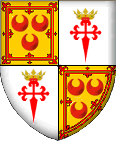 Besides the family estate' of Barnes, which he had from his
father in May 1585, Sir John also had another small grant of
land in his youth. The King, some time before November 1582,
gave him the property of Hailyards, forfeited by James Earl of
Morton "for crimes of lese "majestie"; but, having been under
age at the time of the gift, had to revoke it on 14th November
1582.
Besides the family estate' of Barnes, which he had from his
father in May 1585, Sir John also had another small grant of
land in his youth. The King, some time before November 1582,
gave him the property of Hailyards, forfeited by James Earl of
Morton "for crimes of lese "majestie"; but, having been under
age at the time of the gift, had to revoke it on 14th November
1582.
The ruins of his
planned
16th century residence of Barnes are of unusual type, an example of axial
planning, it is a rectangle 162'6" by 126'8" with the major axis
NE-SW; the walls are of rubble masonry and average 1.8m in
width, with a square courtyard. Square towers project externally from the angles
and between these are spaced intermediate towers - two on the
NW, one on the SE, and one centrally on the SW. At the highest
the walls are 14' but only the vaulted ground floor of the
dwelling portion remains. The walls are laid out in a
highly formal symmetrical Spanish-style, which was very advanced
for its time, defining a square, intended to enclose a
courtyard, with well-defined corner towers. The remains of
Barnes Castle, are in relatively
poor condition and have been used latterly as a farm-store.
It cannot be said therefore that he took
advantage of his opportunities in advancing his own financial
position. After his death, indeed, a charter of his lands of
Barnes was given to Alexander, at that time Lord Urquhart, his
brother, because they were forfeit to the Crown through the
original gift of them to Sir John never having had Royal
sanction.
However, it was not
doubted that if he had lived some time after the King's coming to
the crown of England he would have highly advanced him in honour and fortune, and given his stature and positions, and
having already been knighted and being both a Baron and Lord of
Justice and in
Parliament, and was to have been made an Earl as his two
brothers had been after his decease.
He did however marry Anna Forbes, the eldest daughter to the
7th Lord Forbes, by whom he had two lawful-legitimate sons and a
third illegitimate son (Hannibal Seton, who had
numerous descent), and one daughter, Mosea. His
eldest son succeeded him, and his second son who
was said to have died a young man was actually
Sir George Seton of Hailes. Sir John himself died in the strength
of his age, a relatively young man, having contracted an illness (likely
the Plague) and was buried in the College Kirk of Seton, and he
was succeeded by his eldest son, also styled "Sir John Seton, 2nd of
Barnes".
Although the
later Arms registered for the Seton's of Barnes contain a "sword
supporting an imperial crown", the Seal of Sir John Seton of
Barnes is differenced with a cross-crosslet fitchy, which is
readily mistaken for a sword, and for which cross-crosslet
fitchy supporting a crown is the symbol of the Knights of St.
Iago (or of St. James/Santiago).
Hannibal Seton, of
Haddington also 'of Moneylaggan', Ireland
The record of
Haddington:
The
Testamentar and Inventory of the Goods pertaining to umquhile
Robert, Earl of Wintoun, Lord Seytoun, within the parish of
Tranent and constabulary of Haddington, who died on 22nd March
1603, faithfully made and given up by himself, as far as the
nomination of executors and legacies : and partly by Dame
Margaret Montgomerie, Countess of Wintoun, his relict spouse, so
far as concerning the Inventory... : "...To Hanniball Seytoun
son natural
to umquhile Sir Johne Seytoun of Barnis Knicht my brother ane
hundreth pundis ..."
'Sir John Seaton' (2nd) had in 1642
lands in Ireland Lodge, v. 81, p. 379. Note, he and Lady
Longford fled for safety against the rebels to Castle Forbes.
Hannibal Seton son to Sir John Seton, 12 May 1656. — Haddington
Sheriff-Court Records
Hannibal Seton who also
had settled for a time on the family estate in Ireland, before returning to
Scotland and becoming a Burgess of Haddington; as well as other issue noted in the
historical records of County Longford and surrounding areas in Ireland:
HISTORY OF THE
COUNTY LONGFORD
Under this state of things the following landed gentlemen of the
County of Longford and their families were dispossessed of their
estates, which were either sold to Cromwellian troopers or other
adventurers the hereditary owners having to transplant
themselves and their families beyond the Shannon immediately :
County of Longford, 1657
In 1657, Cromwell assumed the title of Protector and a
sovereignty over the three kingdoms, which so disgusted his
co-regicides that they withdrew from his army, and left him to
enjoy his glory alone ; and the same year he ordered one
Christopher Grough to make out a list of the " forfeiting"
Papist proprietors in each county in Ireland. This list embraces
the names of all those whose estates had been confiscated, but
from which they had not been driven, but were allowed to remain
in a state of dependency ; and in many cases, as if by the
intervention of a kind Providence, the officers of the
Commonwealth, as well as those who were to receive the lands,
either failed to claim them or were persuaded by some momentary
consideration not to disturb the old proprietors, and merely
held the deeds which subsequently made them landlords ;
otherwise there had been no native Irish left in Longford
County.
County of Longford, 1657
Barony of Shrule
Twenty confiscations ; no addresses given :
Nicholas Barne well, James Dillon, Edmond Ffarrell, Ffergus
Ffarrell, Francis Ffarrell, Grarrett Ffarrell, Thomas
Fitzgerald, James Ffarrell, John Ffarrell, Lisagh Ffarrell,
Richard Ffarrell, Teig Ffarrell, Thomas Fitzgerald,
Charles Fox, John Murtagh, John Murlogh, James Quinn, and Sir
John Seaton.
By order of the Governors of Ireland, a census of this
country was taken in the year 1659, when the population of the
County Longford was found to be laid out as follows :
In the barony of Longford there were 396 Irish and 67 English.
The gentlemen residing in the barony were : Sir Arthur Eorbes,
Castle-Forbes ; Alexander Aghmooty, Ballybrian ; William
Pillsworth Minard ; Lieutenant Thomas Babington, Longford
; and Hannibal Seaton, of Moneylagan.
The principal
Irish families were : MacDonnell, 10 people; Farrells, 17;
O'Hagans, 6; MacElvay, 5; Knowlan, 5; Quinn,
4 ; and MacKay, 4. The total population of Longford barony in
those days was 463 people, all told ; of these, 52 formed the
population of Longford borough.
Sir George Seton of Hailes
As the second son of Sir John Seton 1st of
Barnes, his education was provided for by the family at Seton
Palace, and under the tutelage from his uncle Robert Seton, 8th
Lord Seton and 1st Earl of Winton. After completing his
initial studies, he obtained a Degree of M.A.
granted by University of St. Andrews, Doctor of Theology, and was later a fellow
of St. John's College, Cambridge circa 1619-1629, noted in the
"Memorabilia Cantabrigiae" where in he was recommended
personally by King James VI and I. He
was sent abroad for his education, which given early death of his
father and the politics of the day meant that a more modest
education was effected and rather than being sent to France he
was on the recommendation of
King James VI and I to St. John's College at
Cambridge in England. There he was
a noted scholar and was frequently referred as George Seatton of Hallis,
or Dr. Seaton.
With the assistance, or investment, of
his uncle (cousin) George Seton 3rd Earl of Winton, he
acquired and then sold the lands and Barony of Crichton Castle
from James Stewart (the brother of Lord John Stewart, Commendator of
the Priory of Coldingham)
as a result of monies owed, later selling it to Hepburn's of
Humbie in 1649, and the following year he
"quitted" Hailes during Cromwells sacking of that Castle and the
area around Dunbar, and was re-imbursed by the
Government to the sum of 4,700 "in
English money for troops quartered on his tenants and for damage caused by
them", in 1650. In 1650, Hailes was largely dismantled by
Cromwell's forces during the raids in Scotland, along with many other
Seton strongholds, and left in ruins.
Admitted a Burgess and Guild of Leith
12.05.1652, along with his younger son Robert, he remained
active in the support and financing of the Royal family, and in
seeing them returned from exile, for which his estates were
heavily fined and which nearly brought him to ruin
Nevertheless,
following The Restoration,
Sir George
was Knighted and was
eventually granted a pension superscribed by Charles II of £1000 stg. yearly from customs of
London, "to said Sir George; to Robert Seaton his younger son, and to Marie Seaton his
daughter, for their lifetimes" for his loyal services. His son,
Robert Seton married the daughter of the Earl of Eglinton and
had a son, also Robert Seton who was half-brother to the 4th
Earl of Findlater and Chancellor of Scotland.
Charter by the same to George, Earl
of Wintoun, his heirs-male and of taillie, of the lordship and
barony of Haills, with the castle and fortalice, except the
portions thereof disponed to the said George principally, and to
Francis, Earl of Buccleuch, in warrandice and security, as
therein mentioned ; with the patronage of the church of Hauche,
called the prebendary of Lintoun and chaplainry of Markle ;
lands and barony of Auldhamstoks, with patronage of the church
thereof and of the chaplainry of Coldbrandspeth and hospital
thereof; lands of East Craig and Hoprig, and of Morhame, with
tower and fortalice, mill, etc., and patronage of the kirk
thereof, lying within the shire of Edinburgh and constabulary of
Haddington ; lands and barony of Creichtoun, with castle and
manor-place, etc., with patronage of the provostry of Creichtoun
and chaplainries thereof; lands of Murehous, within the shire of
Edinburgh, for the principal; the lands of Quhitsun, etc., with
patronage of the kirk thereof, in the shire of Berwick; lands of
Ferningtoun, with hospital of the same; lands of Langnewtoun,
with tower, mill, etc., in the shire of Roxburgh ; lands and
barony of Dryvisdaill and Carruthers, with patronage of the kirk
of the latter place, in the stewartry of Annandale and shire of
Dumfries ; lands and barony of Dunsyre, Lanarkshire, of
Kirkmichael, Terraughtie, Drumlark, Mabie, and Cruiks ; lands
and barony of Earlstoun, etc., in shire of Dumfries : and in
like manner granting to the said George, Earl of Wintoun, and
his heirs aforesaid heritably, and to the aforesaid Francis,
Earl of Buccleuch, and his heirs-male, etc., in special
warrandice and security, under the conditions contained in a
contract between the said Francis, on one part, and Charles
Stewart, son and heir of the late Francis Stewart, who was
eldest son of the late Francis, Earl of Bothwell, the said
George, Earl of Wintoun, and George Seton, Doctor of Divinity,
and some other persons, on the other part, of date 1647 and
1648; the lands of Traprain ; lands of Nether Hailes, being
parts of the said lordship and barony of Hailes, lying in the
constabulary of Haddington and shire of Edinburgh: which all and
sundry lands, baronies, etc., belonged before to the said
Francis, Earl of Buccleuch, and were resigned by him in
Exchequer at Edinburgh, for this new infeftment, with 4000 ...
to the said George, Earl of Wintoun, etc., and erecting again
the barony of Hailes. Dated 1st March 1648. — Lib. lviii. No.
141.
Hailes had been obtained by a Royal
Grant in March 1647 and again in 1648. The Estate and Barony of
Hailes was passed from Chancellor Seton, to the 3rd Earl of
Winton who purchased the Estate and was confirmed by Royal
Charter, which was passed to his son, Alexander, Viscount
Kingston, and which was held in fee by his cousin of the Barnes
family, Sir George Seton, then called 'of Hailes'. His descent
eventually sold their interest in the Estate when Viscount Kingston
sold Hailes in 1700, to Sir David Dalrymple, Bt., Senator of the College of Justice.
Noted in the Register of Testaments
(Top of column 2 page 645, under)
['XVII. George, fifth Lord Seton'] : — Test. 24 Aug. 1655 of
Robert Seaton, eldest lawful son to Sir Geo. S. of Haills,
Knight. Ed r Com. Records, b. m. 99 x beg. Vide
Test. 30 Aug. 1665 of Robert S. of
Haills, ib. middle. (of the family of Winton).
Test. 3 July 1661, of Sir Geo. Seatton of Haills, Kt., mention
of E. of Winton, and Lord Kingston, b. m. 98 middle. Sir Geo.
Settone of Hailles knighted at Perth day of Nov. 1650. Balfour,
Annals, v. 4, p. 179.
Test. Robert Seton of Hailes. Ed r Com. R. b. m. 43. Robert
Seaton son to the deceased Sir Geo. Seaton mentioned along with
Sir Geo. Stirling of Glorat, Bart., 16 Feb. 1679, Privy Seal Rec
cl vol. 3, 1675-1685, b. m. 89 middle. 2
Test. Sir Geo. Seaton of Hailes, 3 July 1661, b. m. 91 near beg.
Inventory of
the Papers of Captain Robert Seton, Grandson of Sir George Seton
of Hailes.
1. Parcel containing a very large number of receipts for money,
and discharged accounts
— not arranged, and of various dates, 1688-1705.
2. An Edinburgh Burgess and Gild Ticket — date illegible.
3. Precept under the sign-manual of Charles 1. directed to Sir
John Mallarie, Kt.,
Governor of Skipton, for payment of
£200 to Sir
Francis Cobb. Dated at Newarke, 28th
October 1645.
4. Band by David Litle in Tranent to Mr. George Seatoun of
Hailes. 8th May 1649.
5. Band by James Dunlape, Writer, Edinburgh, to Sir George
Seatton of Hailes. 4th
October 1650.
6. Gift under the sign-manual of Charles 11. in favour of Sir
George Seaton of Hailles
for the yearly pension of
£1000
English. Dated at Perth, 26th November 1650.
7. Indenture between Dame Barbara Cobb, widow, and Sir William
Cobb. 1st Decem-
ber 1677.
8. Bond by Robert Seattoun to Harie Sinclair, writer, Edinburgh.
London, 19th August
1680.
9. Agreement between Robert Settoun, son to the deceased Robert
Settoun of Hailes,
and James Charteris, W.S., on their departure for London (to go
together). Edinburgh, 15th
March 1682.
10. Letter, the Earl of Findlater to Robert Seaton, Cullen. 29th
January 1685.
11. Letter to Lieutenant Seton. 9th May 1687.
12. Letter from John Gifford. 2nd January 1688.
13. Commission under the sign-manual of James vn. to Robert
Seton to be ' Captain
Lieutenant,' dated 1688. (Imperfect from decay.)
14. Commission to Robert Seaton to be Captain in Sir Edward
Hale's Regiment. 27th
November 1688.
15. Attestation that Robert Seaton has received the Sacrament.
168- (?).
16-18. Three letters from Sir William Cobb, dated 2nd and 14th
January and 2nd
February 1690-91.
19. The Testament of Dame Frances Smith, wife of Sir Edward
Smith, Bart. 28th
November 1692.
20. Letter from to Robert Seaton, Esq. 28th February 1692.
21. Obligation by Rebecca Hayes. Dated 23rd March 1692-93.
22. Letter from to Captain Seaton. 29th October 1694.
23. Messenger's Copy of Privy Council Warrant for the arrest of
Captain Seton for high
treason. Kensington, 23rd February 1695-96.
24. Baile for Robert Seton, Esq.
25. Draft Letter of R. S. to Sir William Cobb. August 1697.
26. Letter to Lady Cobb. 29th June 1699 [89?].
27. Memorandum of Accompts between T. W. and R. S. 1695.
28. Release by Alexander, Earl of Eglinton, to his nephew,
Robert Seton. 6th February
1700.
29. Letter of Procuratory (Missive) by the Earl of Eglinton to
Robert Seton. 21st
October 1700.
30. Articles of Agreement between Joseph Sanders of Legh (Leith),
merchant, Thomas
Sanders of London, merchant, and Robert Seton. 3rd November
1701.
31. Letter from John Bogle, Glasfgow], to Captain Robert Seton.
8th August 1705.
32. Packet containing fifteen letters of various dates from Lady
Barbara Cobb, a memo-
randum-book, and an envelope containing a lock of the hair of
Sir John Fenwick, beheaded
on Tower Hill, London, 28th January 1696-7.
33. A Diploma of the University of St. Andrews to Master George
Seton, with fine seal
attached. 1629.
34. Household Book of Lady Barbara Cobb from about 1660 to 1680.
35. Ane Compt of the losses of Sir George Seattoun of Hailes and
his Tenants within
the parish of Prestonhaugh since the Inglisch armie came into
Scotland. 1650-51.
36. Charge of the Money received by James Millar of Gurlabank
belonging to Sir George
Seattoun of Hailes from 28th August 1651 to 28th September 1652.
The papers referred to in the preceding Inventory were found in
an old trunk in one of the cellars below the dome of the
Register House, Edinburgh, in November 1895, by Mr. M.
Livingstone, Deputy Keeper of Records, to whom we are indebted
for the interesting list.
The annexed
pedigree will show the relationship of several of the persons
referred to : — Hugh, seventh Earl of Eglinton.
Sir George Seton of Hailes.
Alexander Montgomerie, eighth Earl of Eglinton, who's daughter
Lady Anne Montgomerie married Robert Seton, son of Sir George
Seton of Hailes. When he died, she married 2nd James,
third Earl of Findlater.
Captain Robert Seton, only son and heir of Robert Seton of
Hailes, and half-brother to the 3rd Earl of Findlater.
Marie Seton, second child and only daughter of Robert Seton of
Hailes.
It had hitherto been unable by earlier writers to ascertain the
parentage of Sir George Seton of Hailes, who, before being
knighted, appears in the Great Seal Register as ' Mr.' and '
Dr.' In the elaborate Diploma of the University of St. Andrews
(No. 33 of the Inventory), he is described as a Doctor of
Theology and a Fellow of St. John's College, Cambridge. However
it was later determined that in fact, he was the second son of
Sir John Seton, 1st of Barnes who had not 'died young' as
previous writers had claimed, and who's line had been completely
ignored.
The Edinburgh Burgess Ticket (No. 2), of which the date is
illegible, relates to either
the Robert Seton who married Lady Anne Montgomerie, or to his
son, also Robert.
The 'Attestation' (No. 15) is from the Church of St.
Martin-in-the-Fields, Middlesex.
Sir William Cobb (Nos. 7 and 16) was probably son and successor
of Sir Francis Cobb
(No. 3) by his wife ' Dame Barbara.'
The 'Arrest' mentioned in No. 23 was in all likelihood connected
with the 'Assassination
Plot' against William of Orange, in which Sir John Fenwick (No.
32) was concerned. |
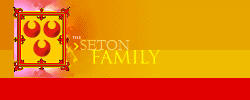

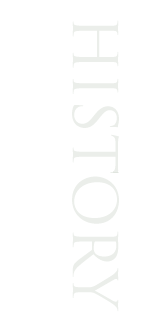

 The Seton's of Barnes, Hailes,
'of Moneylagan' in Ireland, Ireland and
Nova Scotia
The Seton's of Barnes, Hailes,
'of Moneylagan' in Ireland, Ireland and
Nova Scotia
 At the heights of his favour with King Phillip of Spain, was
commanded home by King James the Sixth, unwilling to want so
gallant a subject out of his court and service. Upon his return
home, King James preferred him to be Treasurer of
his House and was in great favour with his Majesty. He was
created Lord Barnes (1587 to 1594) of the Lords of Session
in Parliament as an Ordinary Lord, in the place of his younger
brother Alexander promoted. Following his services and
reputation in Spain, he was likewise created Master
of the Kings Household (like that of his father), and Master of
the Kings Horse, and was added Treasurer of the Royal Household
as well.
At the heights of his favour with King Phillip of Spain, was
commanded home by King James the Sixth, unwilling to want so
gallant a subject out of his court and service. Upon his return
home, King James preferred him to be Treasurer of
his House and was in great favour with his Majesty. He was
created Lord Barnes (1587 to 1594) of the Lords of Session
in Parliament as an Ordinary Lord, in the place of his younger
brother Alexander promoted. Following his services and
reputation in Spain, he was likewise created Master
of the Kings Household (like that of his father), and Master of
the Kings Horse, and was added Treasurer of the Royal Household
as well. Besides the family estate' of Barnes, which he had from his
father in May 1585, Sir John also had another small grant of
land in his youth. The King, some time before November 1582,
gave him the property of Hailyards, forfeited by James Earl of
Morton "for crimes of lese "majestie"; but, having been under
age at the time of the gift, had to revoke it on 14th November
1582.
Besides the family estate' of Barnes, which he had from his
father in May 1585, Sir John also had another small grant of
land in his youth. The King, some time before November 1582,
gave him the property of Hailyards, forfeited by James Earl of
Morton "for crimes of lese "majestie"; but, having been under
age at the time of the gift, had to revoke it on 14th November
1582.